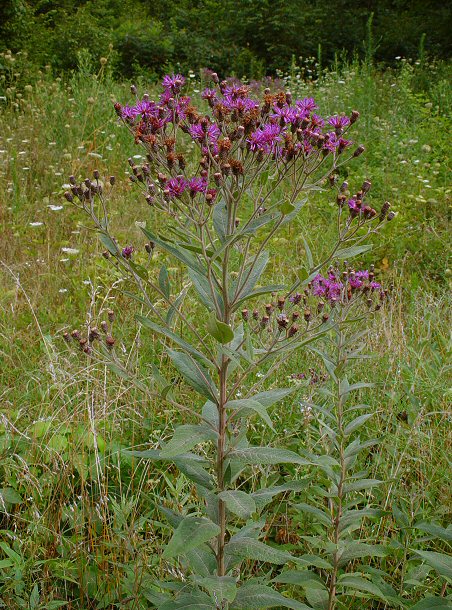Vernonia baldwinii Torr.
Western Ironweed

Native
CC = 2
CW = 5
MOC = 98
© DETenaglia
Vernonia baldwinii Torr.Western Ironweed | |
 |
Native CC = 2 CW = 5 MOC = 98 |
© DETenaglia |
|
Family - Asteraceae/Vernonieae Habit - Perennial forb with a stout rootstock, often rhizomatous. Stems - Ascending to erect, to 1.5 m, typically single from the base, branched near apex, stout, with relatively long, spreading or often bent hairs, occasionally with only minute hairs toward the tip.
Leaves - Alternate, simple, sessile or short-petiolate. Petioles to 7 mm, velutinous. Blades 6-18 cm long, lanceolate to ovate or elliptic-ovate, tapered to angled at the base, tapered at the tip, the margins finely to less commonly coarsely toothed, the upper surface minutely hairy, the undersurface with more or less evenly distributed, relatively long, often bent or tangled hairs, also dotted with impressed glands. Venation impressed adaxially and expressed abaxially.
Inflorescences - Irregularly branched terminal panicles, often flat-topped. Peduncles velutinous, to 2 cm long.
Heads - Discoid, with 17-34 florets. Involucre 4.5-8.0 mm long, short-cylindrical, the bracts 4-7 mm long, lanceolate to ovate, angled or more commonly short-tapered to a sharply pointed tip, loosely ascending or the tip recurved-spreading, glabrous or minutely hairy, usually with abundant minute, impressed resin glands on both sides of the midvein, the margins usually cobwebby-hairy, brownish green to dark purple, the midvein usually noticeably keeled. Receptacle flat, naked.
Florets - Ray flowers absent. Disk florets with the corollas 8-10 mm long, deep pink to purple, 5-lobed, glabrous. Stamens 5, adnate in upper 1/3 of corolla tube. Filaments white, glabrous. Anthers yellowish, connate around style, partially to fully exserted, to 3mm long. Style pinkish-white, well exserted beyond corolla and anthers, bifurcate. Pappus tan to brown, often purplish-tinged, the inner bristles 5.0-6.5 mm long, the outer scales 0.5-0.8 mm long.
Fruits - Achenes 2.5-4.0 mm long, narrowly oblong to narrowly oblong-triangular in outline, not flattened, with 8-10 relatively narrow ribs, usually hairy, at least along the ribs, often with minute resin dots between the ribs, grayish brown to brown. Flowering - May - September. Habitat - Upland prairies, glades, tops of bluffs, savannas, upland forests, pastures, fencerows, fields, railroads, roadsides, open disturbed areas. Origin - Native to the U.S. Lookalikes - Other species of Vernonia. Other info. - This striking species is found throughout Missouri. Beyond Missouri its range is predominantly within a roughly circular area near the center of the continental U.S., with more scattered populations extending into Texas. The plant is identified by its large panicles of purple flowering heads and leaves with densely hairy undersides. Differentiation from other species of Vernonia is subtle and can be difficult. Primary characters to examine are the hairs on the leaf underside and the involucral bracts. In this species, the latter are loosely ascending to recurved, as shown in the photos above. However, the situation is muddied by the fact that members of this genus interbreed promiscuously, producing forms which show a range of intermediate states. These crosses are very common. As a final touch, Missouri plants have been subdivided into two subspecies, again based on the involucral bracts. Variety baldwinii has loosely ascending bracts, and var. interior has recurved bracts. Photographs taken at the Current River Conservation Area, Reynolds County, MO., 7-15-01 (DETenaglia); also at Shaw Nature Reserve, Franklin County, MO, 6-30-2007, and along the Katy Trail near Dutzow, Warren County, MO, 7-4-2014 (SRTurner). |